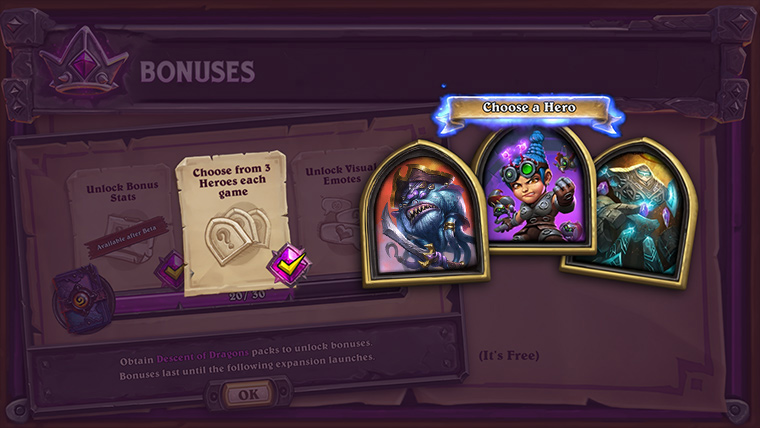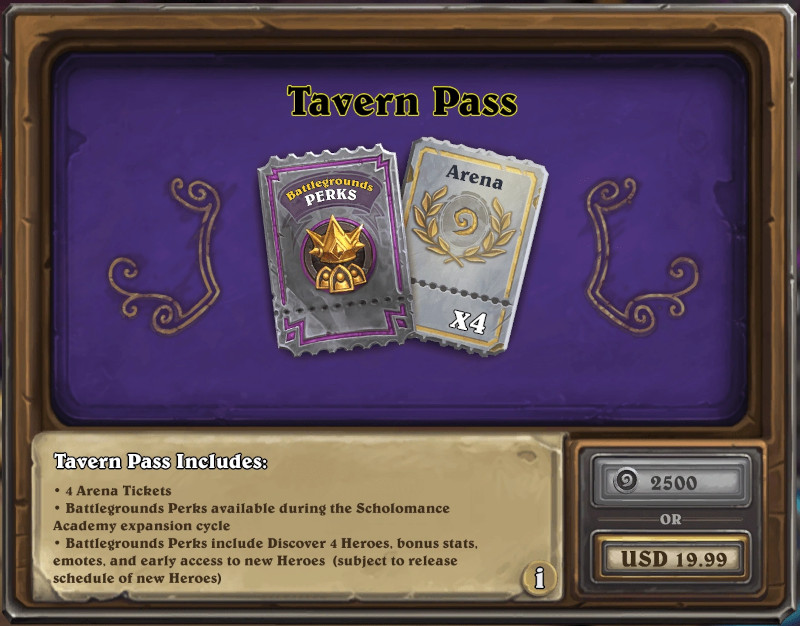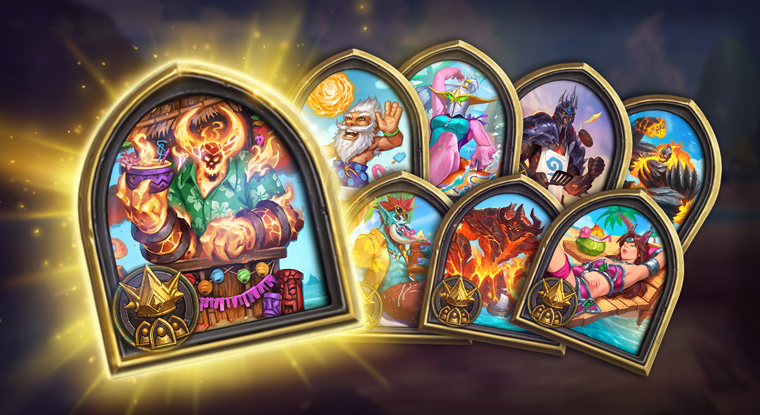Hearthstone Battlegrounds has been a huge success. Since it was launched in November 2019, Battlegrounds has climbed in popularity to match and even overtake the traditional constructed Hearthstone. This success has been a mixed blessing for Blizzard. On one hand, it has given Hearthstone additional popularity. On the other hand, Battlegrounds has not been monetized nearly as well as constructed. Now, the upcoming Battlegrounds patch aims to change this by giving a competitive advantage to people who pay real money. You will have access to four Hero options in each game if you pay real money. If you don’t, you can only choose from two.
In this article, I will take a deep dive into Battlegrounds monetization. How have we reached this point? What has Blizzard attempted before? And crucially, exactly how much of an advantage can you gain by paying?
The Beginning: Battlegrounds as a Side Mode
The launch of Battlegrounds looks amusing in hindsight. Battlegrounds was not even a main menu item! It was hidden behind a Modes button together with the other superstar, Arena.
Battlegrounds monetization was almost non-existent. You could unlock the ability to choose from three Heroes instead of two by buying 20 packs from the latest Hearthstone expansion. You could buy these packs with Gold, so you were able to unlock them without paying real money. On the other hand, you could not earn Gold by playing Battlegrounds, so you needed to venture to other game modes or buy packs with real money to unlock the expanded Hero selection.
Battlegrounds was not monetized for success. It was clearly a side mode that you would get some perks in by investing in the main game mode, constructed.
The original Battlegrounds was there just for fun. Who would have guessed that a game built just for fun would be popular? The entire concept must seem completely alien in some decision-making circles.
Battlegrounds Perks, the First Step Into Monetization
Battlegrounds monetization was separated from the constructed format with the introduction of Tavern Pass and the associated Battlegrounds Perks in March 2020. Funnily, Battlegrounds was now bundled together with Arena. They were both still considered side modes in the game.
At this point, the paid Hero options were expanded from three to four.
As there was still no way to earn Gold within Battlegrounds, you would need to play the other modes to buy your Tavern Pass if you did not want to spend real money. This way, at least Battlegrounds could siphon some Gold away from the system now that you no longer received cards on top of the perks. Of course, a true Hearthstone player would still play constructed as their main game!
Hearthstone Rewards Track, the Beginning of the Separation
With the launch of Hearthstone Rewards Track in November 2020, it was finally possible to earn Gold by playing Battlegrounds. Blizzard was starting to admit that people would play Battlegrounds without touching the other game modes. Furthermore, it was possible to earn enough Gold simply by playing Battlegrounds to buy the perks each season, and as a Battlegrounds main, you would have few other uses for your Gold anyway, so Battlegrounds became more free-to-play than before!
This was obviously a huge problem for Blizzard. People were now playing Battlegrounds and having fun and doing it completely for free! We do not have game-mode-specific revenue figures, but it is entirely possible for Battlegrounds to have operated at a loss at this point. After all, there was hardly any reason or way to spend money on it.
Cosmetics to the Rescue?
The obvious solution to people not having anything to spend money on in a game is to start selling cosmetics. For Battlegrounds, this happened in July 2021 when Hero skins were introduced to the game. With 84 Heroes in the pool and more being added, there is room to make a lot of skins. In just over a year, Blizzard has added more than 100 Hero skins that can be purchased with real money to Battlegrounds.
In addition to Hero skins, Blizzard added Bartender skins in the same patch. As of now, there are 18 alternative Bartender skins in the game.
New cosmetics have been released at an increasing pace. In November 2021, Blizzard added new game boards and in February 2022 they added Strikes (initially called Finishers), which are special animations that play when a Hero is defeated.
Blizzard has not published any data on the financial performance of Battlegrounds cosmetics.
Time to Make Them Pay!
Finally, in August 2022, Blizzard abandoned the completely free-to-play approach to Hearthstone Battlegrounds. In a reward system revamp, they introduced a new Battlegrounds Track. Much like the Hearthstone-wide Rewards Track, the new Battlegrounds Track includes a free track and a premium track. You progress through the track by winning Battlegrounds matches (finishing in the top four) and completing new Battlegrounds missions.
Unlike the general Rewards Track, the Battlegrounds Track is heavily premium-focused. The free track gives you five Hero skins, three Emotes, and two Strikes. The paid premium track gives 15 Hero skins, nine Emotes, three Strikes, a board, and a Bartender skin. Crucially, it also opens access to four Hero options in each game. The premium track is only available for real money. The cost will be equivalent to Battlegrounds Perks, so around $20 in the US.
How Pay-To-Win Is Battlegrounds Now?
The only gameplay leverage Blizzard has had in Battlegrounds is the number of Hero options offered to you in each game. Until now, it has been possible to unlock the bigger selection with in-game currency earned from playing, but now that is no longer the case. But how big is the advantage, exactly?
We can view the advantage through several lenses.
The advantage will depend on the meta. After all, if every Hero is equally powerful, it does not matter which one you choose!
For groundwork, it is important to know how strong various Heroes are. The strength of the Heroes heavily depends on your rating. As you move up the ladder, the good Heroes become stronger and the weak Heroes become weaker. This is easy to understand if you think that the best players will be able to fully utilize the strengths of their great Heroes, whereas lower on the ladder you can achieve good results with strong fundamentals even if your Hero Power is not that strong.
As an illustrative example, HSReplay data at various ranks show how the Hero pool becomes smaller as we move up the ranks.
At the top 50% of the ladder, all Heroes are still used:
- Tier 1: 2 Heroes
- Tier 2: 32 Heroes
- Tier 3: 26 Heroes
- Tier 4: 24 Heroes
- Total: 84 Heroes
As we move higher, the data on weaker Heroes becomes more scarce and HSReplay is no longer able to predict their strength.
At the top 5% of the ladder, the weakest Heroes see too little play to show up on data:
- Tier 1: 1 Hero
- Tier 2: 38 Heroes
- Tier 3: 16 Heroes
- Tier 4: 12 Heroes
- Total: 67 Heroes (no data available on 17 Heroes)
Things get even more pronounced as we move to the top 1%:
- Tier 1: 1 Hero
- Tier 2: 31 Heroes
- Tier 3: 2 Heroes
- Tier 4: 3 Heroes
- Total: 37 Heroes (no data available on 47 Heroes)
The performance of the weaker Heroes becomes weaker and weaker as we move up the ranks until they disappear from the data altogether.
Looking at the top 1% data, Heroes from tier 1 and tier 2 are performing better than the lobby average. There are 32 such Heroes out of 84 total Heroes. Using hypergeometric probability, we can calculate how often you are offered one of these better Heroes when you have access to two options or four options:
- Chance to be offered a good Hero with 2 Hero options: 62%
- Chance to be offered a good Hero with 4 Hero options: 86%
That is a major difference. Think of it this way: if you have four Hero options, you will have to play one game out of ten with a weaker Hero (after rounding the numbers). If you have only two Hero options, you will have to play four games out of ten with a weaker Hero. Now, some of those Heroes will be only marginally weaker than your preferred Heroes, but the difference between Heroes grows as we move up the ladder, so there will be a significant number of games where you will be at a clear disadvantage.
We can also look at the matter through another lens. How much will your expected performance change depending on the number of Hero options you have available? As we start losing performance data of weaker Heroes higher on the ladder, there will be some level of conjecture here. The process is to look at all the combinations of offered Heroes, pick the best one offered each time, and determine the average performance of that pool.
At the top 50%, where we still have data of all Heroes, your expected finish in the current meta with four Hero options is 4.3. Your expected finish with two Hero options is 4.4. That might not seem like a huge difference, and it’s not if you only count a few games, but it does show up in your rating over time.
As we go up to the top 1%, the calculation becomes more difficult. We know that the performance of the weaker Heroes becomes worse before they disappear from the data set entirely. But we no longer have figures that are equally clear. Depending on the assumptions, the difference here is either 4.1 vs 4.3, 4.1 vs 4.4, or 4.2 vs 4.4. Against good players, the handicap from having fewer Heroes to choose from doubles or triples compared to the handicap lower on the ladder.
In the top 1%, the handicap from not having four Hero options is highly significant. I don’t expect many non-paying players to reach those ranks because of that.
In principle, the top 1% shows the true handicap. People lower on the ladder are just not good enough to make the most of it, and that gives you a chance to succeed with strong fundamentals even with a weaker Hero. No such quarter is given higher on the ladder. Pay up, or don’t bother climbing ranks.
The Monetization of Hearthstone Battlegrounds
Hearthstone is rarely mentioned in Blizzard’s financial reports. We know that Blizzard is profitable. We also know that their income and especially the income from World of Warcraft has been going down for a long time now. Hearthstone has also seen better times: the few mentions it has earned in the quarterly reports are from lower revenues on Q1 2021, Q2 2021, and Q1 2022. Blizzard started adding more monetization to Battlegrounds in Q3 2021. Perhaps those attempts were enough to stop the bleeding, but they were not enough to jump up Hearthstone revenues. Now, Blizzard is bringing in the big guns. Still, we lack insight into individual game modes. We do not know whether Battlegrounds is profitable. But we know that Blizzard is determined to make more money with it than they have been making so far and they seem to be prepared for a major PR backlash to get their money. I mean, there is no way they did not anticipate a reaction to these latest changes.
This might not be the last chapter in Battlegrounds monetization. Sufficient backlash might make Blizzard back down and try to find different avenues to get their revenues. Even if it does, Blizzard is determined to make more money with Battlegrounds, one way or another.




well after that, they prob gonna try to improve mercenarie to be more pay-to win then f2p
Come on Blizzard, they can’t get enough of money it’s insane!
They always come with new things how they can take more money out of their players pockets.
Prior to the rewards track you’d get 10 gold for 3 wins in BGs, plus any incidental quests you completed while playing BGs (thinking play 3 games and win 2 games here)
You’re right, 10 Gold per 3 wins was also obtainable in Battlegrounds. However, given how long the average BG match is, that extra Gold was negligible. If you were an average player (50% WR) and played 4 Battlegrounds matches per day, you only got ~6.6 Gold per day on average. That’s ~200g per month.
(Still, it might be worth mentioning in the article.)
Battlegrounds is very popular now. But if charging $20 every four months is “too expensive” for it’s player base, it won’t ever be worth supporting, and would have to be discontinued. It’s that simple.
It’s really sad see this sh#t monetization bounded with new content because eclipses all good with a real drama. Good note Old Guardian, nice ideas. Just left one: feeling on players (middle to high rank) about the game is unfair vs F2P, that will undermine everybody confidence to climb. :/
Sad times for the BGs players. Loved the article, though! I truly hope the backlash is enough to make them rethink locking the additional heroes behind a paywall.